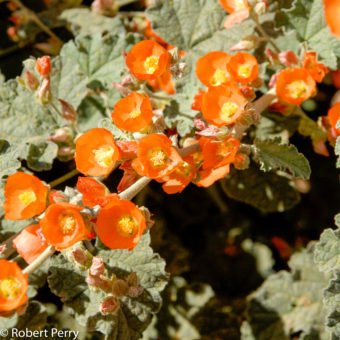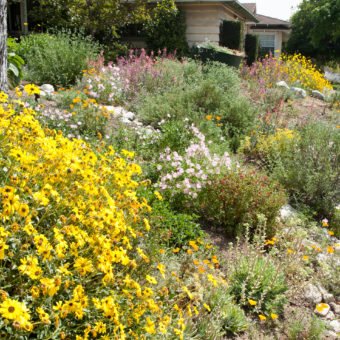A densely branched shrub growing 2-4 ft. high and 4-6 ft. wide, sometimes wider. Prickly foliage is comprised of small needle-like leaves. White to light pink flowers occur in late spring; seed heads mature to deep brown by late fall and persist into winter. California buckwheat is the most wide spread species of buckwheat in California. It grows in the coastal sage scrub plant communities in coastal and inland bluffs, plains and foothills. With in its range, it has proven to be adapt able to many types of soils, as well as heat, aridity and drought. It provides pollen for honey bees and produces an abundance of seeds for birds. This species is widely used for slope stabilization and restoration of natural areas, and is easily established by seed. A number of prostrate cultivars are grown as groundcovers in native plant gardens.
California buckwheat
Eriogonum fasciculatum
Description
Plant properties
Water needs
Maintenance
Plant Type: Shrub, Ground cover, Native
Foliage Character: Evergreen
Habit: Mounding, Dense
Growth Rate: Moderate
Foliage Color: Medium green
Flower Color: Pink, White
Flower Season: Spring
Soil Adaptations: Well-draining soil, Clay, Calcareous soil
Exposure Adaptations: Heat, Drought, Aridity, All day sun
Function: Background plant, Attracts bees, Attracts butterflies, Wildlife value, Slopes, Restoration, Banks
Height: 3 ft. – 4 ft.
Width: 4 ft. – 6 ft. +
Foliage Character: Evergreen
Habit: Mounding, Dense
Growth Rate: Moderate
Foliage Color: Medium green
Flower Color: Pink, White
Flower Season: Spring
Soil Adaptations: Well-draining soil, Clay, Calcareous soil
Exposure Adaptations: Heat, Drought, Aridity, All day sun
Function: Background plant, Attracts bees, Attracts butterflies, Wildlife value, Slopes, Restoration, Banks
Height: 3 ft. – 4 ft.
Width: 4 ft. – 6 ft. +
Watering Schedule: Low 1
For most situations, we recommend watering deeply every 3-4 weeks after establishment.
Learn how to apply this watering schedule to your landscape on our How to water waterwise and California native plants page.
Important Notes
- These are general guidelines. Always observe and adjust as necessary for your landscape.
- If it rains over 1” you will likely not need to water for at least another 3-4 weeks. Before watering again, check the soil. It should be significantly dry at least 4” below the soil surface before watering.
- If you have a “smart timer” or weather sensitive irrigation controller, it is best not to use the automatic weather adjusting features for plants in this category. While very useful for watering higher water demanding plants, those in this category have natural drought adaptations which mean they do not need to be watered more in warm weather. Using the weather adjusting features will result in either overwatering in summer or underwatering in fall and spring.
- It is important to group plants with the same water needs together in the landscape to avoid needing to over or under water plants when running your irrigation system.
To control size, cut back as much of the new-ish growth as desired while not in flower (April-ish). Do not prune in late spring as you will remove forming buds which will form this season’s blooms. After flowering, leave spent flowers to dry into red / brown clusters. This is part of the desired look of native buckwheats. The seeds develop into valuable wildlife food and help shade the plant in the summer heat (1). “Deadheading” buckwheats would be tedious and time consuming and would take away much of what there is to love about this plant. Keep things easy and don’t worry about it (S). If desired, remove dried seed heads beginning in mid-September and into the fall (1). Older plants that look like they need refreshing can be cut back hard into older wood in November, although there is always a possibility they will not regrow. Expect new growth to emerge within a few weeks (1). A more conservative option is to cut back hard, but only cut back above the lowest few sets of leaves. This may not be as satisfactory aesthetically, but may be less of a risk of plants dying (3, S). If desired, they can also be lightly headed back in fall just to clean up form and encourage denser growth (7).
References
Plant Lists
Sign Up For Free
To access all the features of this website, please create an account with us. Privileges include:
- Ability to print plant groups, lists and plant profiles
- Create your own plant groups
- Receive monthly updates by email
An online resource for you to learn about and choose the best plants for your inland Southern California landscape.
Promoting water conservation through education, stormwater capture, waterwise landscapes, and other initiatives.
We provide programs, services, and resources to serve audiences of all ages to cultivate a community-wide conservation ethic and build regional capacity for water resilience.













